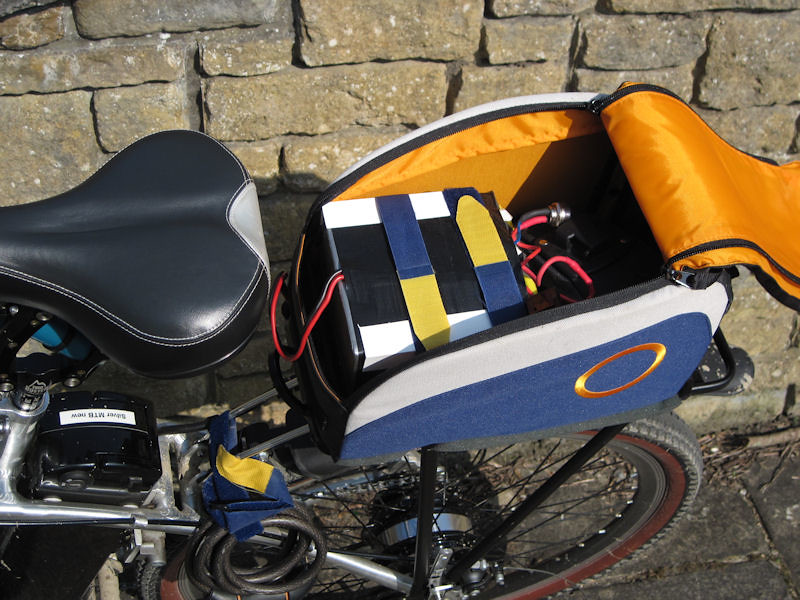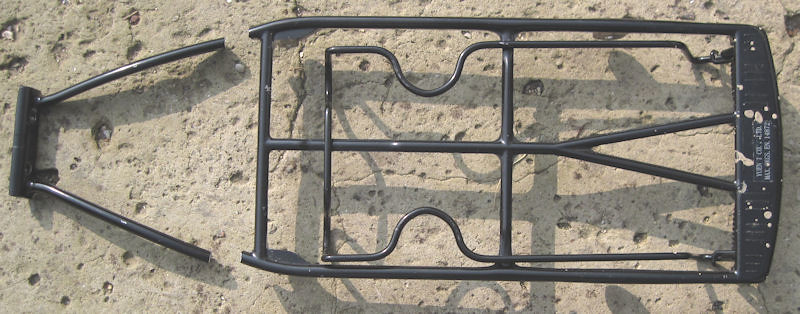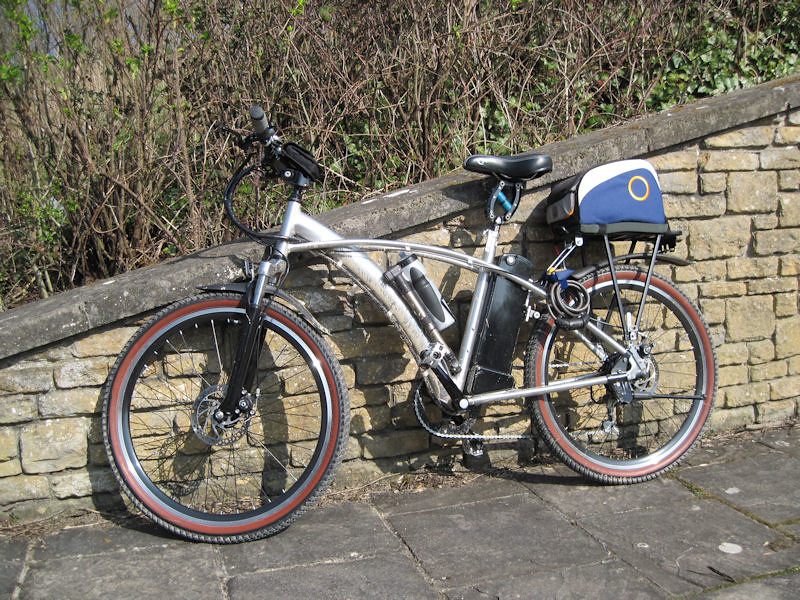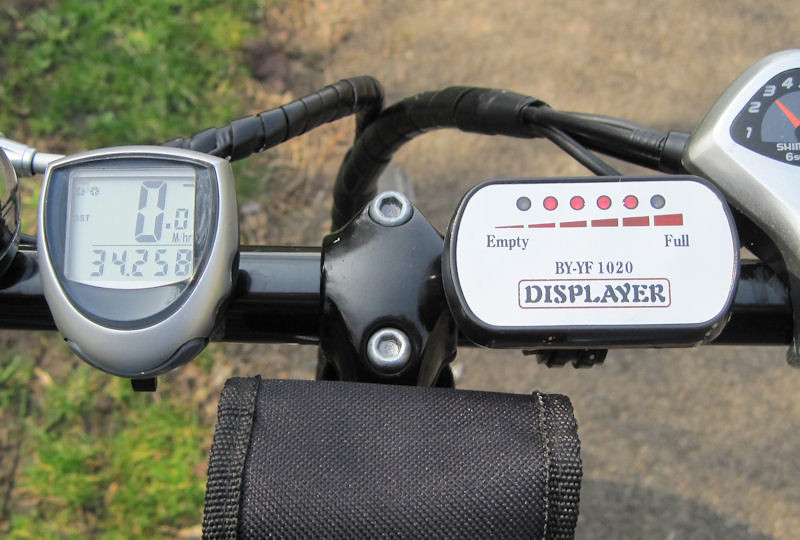This 36v 10ah LiFePO4 battery, supplied by Li Ping in China was purchased towards the end of April 2008 at a cost of £153 delivered. The battery has never been subjected to a daily charge/discharge cycle, only ever being used as a range extender and to 'get-me-home' when conditioning other batteries. As with most batteries used for this purpose, it often sits unused and forgotten in a cupboard for several months at a time. Compared to other types of batteries I have, it certainly has the lowest self discharge rate. Even after five months in storage it only accepts ten minutes at constant current followed by twenty minutes at constant voltage during the cell balancing phase. Given this type of usage, the trials on this battery relate only to calendar ageing. Had it been used for daily commuting, the results could have been different.
With this 3.5 Kg mini power-house safely strapped into a trunk bag on my Juicy Sport, I set off to establish how far this three-year-old battery would take me.

Those who remember my report on the 'Ridgeway Route' will be aware of my decision to fit an independent throttle to the Juicy following that ride. The Juicy controller had a throttle input, but the firmware was set up for European use, the throttle only active while pedalling, not what I wanted!. Occasionally, I have to walk the machine up hills which are too steep to ride. A thumb throttle was fitted, but only for use when walking the machine. The throttle was not used during this trial.
The 15 amp controller now fitted was saved from my old Synergie Bayamo. This was a new replacement controller for the water damaged original. Supplied by Europa Cycles, the then importers of Synergie Bikes, it is identical to the 'Santroll' unit used on Alien kits, although the firmware may differ. The characteristics are as follows:
Pedelec assist tapers down at 14-15 mph, the level of assistance being proportional to chainwheel speed. I suspect only around 12 amps is available in pedelec mode, with the full 15 amps available on the throttle as a power boost. Riding on throttle only, the Juicy happily romps along at 17 to 18 mph. As you can see, providing the throttle is not used, it's a very mild-mannered controller. The 48/14 road gearing means it is very easy to keep the road speed at the assist ramp-down given my 'utility' cadence of 55 to 60 rpm. I should also mention most of the trial was on cycle routes, lots of stops and slow-downs.
Fifteen miles into the first days ride, when bumping over some very rough ground, an ominous 'CRACK' from behind brought everything to an abrupt halt. The carrier rack had snapped on both sides, pushing the mudguard down onto the rear tyre like a whopping great band-brake!!. With the aid of the little saw in my LeatherMan, a couple of sticks were cut from the hedgerow. Lashed into place with the laces from a pair of discarded trainers hanging in a bush, the 'splints' kept the carrier off the wheel for the remaining four miles to my home.

Wanting to continue the trial the next morning, the original Juicy carrier was fitted to the machine, but as you can see, it's not really a good match, sitting far too high. This is the reason I did not use it in the first place.

By the way, if you read the review of the latest Juicy Sport in the Electric Bike Magazine, you will notice the current version of the 'Sport' has gotten a whole lot better, I'm tempted!, especially with the prospect of some high capacity batteries on the horizon.
The Ping finally threw in the towel on a moderately steep up-slope, with an impressive thirty-four miles on the clock.

Typically for a Ping battery, in the short time it took to get my camera off my belt, it had recovered enough to bring several led's back on. Had I started to ride again, two hundred yards would have resulted in another low voltage shut-down, the battery was, for all intents and purposes, EMPTY!.
A few non technical, unscientific and 'somewhere-around' details:
The consumption meter showed the Ping absorbed 445 watt-hours including the fan-cooled charger losses. I don't think it would be unrealistic to assume this lightly used battery has not lost any capacity since new. Based on a nominal 360 watt-hours capacity, the ride consumed 10.51 watt-hours per mile, about average for any of my hub-motored bikes.
Around 2005/6, there were a lot of steel framed full sussers such as my Synergie Bayamo in use. These machines, powered by puny 8ah sla's tipped the scales at 38 Kg, in hilly territory you'd be lucky to get twelve miles on a charge. Fortunately, a Ping 36v 10ah could be configured 'tall and slim' and could easily be fitted into the battery casing of these early E-bikes, greatly enhancing the usefulness of those machines.
Nowadays, many Lithium batteries are housed in the industry standard alloy casings such as that fitted to Synergie Mistral and others. Unfortunately, the physical dimensions of the cells used by Li Ping means he cannot configure an array to fit these popular battery casings, such a shame!.
All the best.
Bob.
To Bob Wales of Juicy Bikes:
It was good to meet you the other day, my apologies to your wife for keeping you chatting for too long.
Regards.
Bob W.
Swindon.
With this 3.5 Kg mini power-house safely strapped into a trunk bag on my Juicy Sport, I set off to establish how far this three-year-old battery would take me.

Those who remember my report on the 'Ridgeway Route' will be aware of my decision to fit an independent throttle to the Juicy following that ride. The Juicy controller had a throttle input, but the firmware was set up for European use, the throttle only active while pedalling, not what I wanted!. Occasionally, I have to walk the machine up hills which are too steep to ride. A thumb throttle was fitted, but only for use when walking the machine. The throttle was not used during this trial.
The 15 amp controller now fitted was saved from my old Synergie Bayamo. This was a new replacement controller for the water damaged original. Supplied by Europa Cycles, the then importers of Synergie Bikes, it is identical to the 'Santroll' unit used on Alien kits, although the firmware may differ. The characteristics are as follows:
Pedelec assist tapers down at 14-15 mph, the level of assistance being proportional to chainwheel speed. I suspect only around 12 amps is available in pedelec mode, with the full 15 amps available on the throttle as a power boost. Riding on throttle only, the Juicy happily romps along at 17 to 18 mph. As you can see, providing the throttle is not used, it's a very mild-mannered controller. The 48/14 road gearing means it is very easy to keep the road speed at the assist ramp-down given my 'utility' cadence of 55 to 60 rpm. I should also mention most of the trial was on cycle routes, lots of stops and slow-downs.
Fifteen miles into the first days ride, when bumping over some very rough ground, an ominous 'CRACK' from behind brought everything to an abrupt halt. The carrier rack had snapped on both sides, pushing the mudguard down onto the rear tyre like a whopping great band-brake!!. With the aid of the little saw in my LeatherMan, a couple of sticks were cut from the hedgerow. Lashed into place with the laces from a pair of discarded trainers hanging in a bush, the 'splints' kept the carrier off the wheel for the remaining four miles to my home.

Wanting to continue the trial the next morning, the original Juicy carrier was fitted to the machine, but as you can see, it's not really a good match, sitting far too high. This is the reason I did not use it in the first place.

By the way, if you read the review of the latest Juicy Sport in the Electric Bike Magazine, you will notice the current version of the 'Sport' has gotten a whole lot better, I'm tempted!, especially with the prospect of some high capacity batteries on the horizon.
The Ping finally threw in the towel on a moderately steep up-slope, with an impressive thirty-four miles on the clock.

Typically for a Ping battery, in the short time it took to get my camera off my belt, it had recovered enough to bring several led's back on. Had I started to ride again, two hundred yards would have resulted in another low voltage shut-down, the battery was, for all intents and purposes, EMPTY!.
A few non technical, unscientific and 'somewhere-around' details:
The consumption meter showed the Ping absorbed 445 watt-hours including the fan-cooled charger losses. I don't think it would be unrealistic to assume this lightly used battery has not lost any capacity since new. Based on a nominal 360 watt-hours capacity, the ride consumed 10.51 watt-hours per mile, about average for any of my hub-motored bikes.
Around 2005/6, there were a lot of steel framed full sussers such as my Synergie Bayamo in use. These machines, powered by puny 8ah sla's tipped the scales at 38 Kg, in hilly territory you'd be lucky to get twelve miles on a charge. Fortunately, a Ping 36v 10ah could be configured 'tall and slim' and could easily be fitted into the battery casing of these early E-bikes, greatly enhancing the usefulness of those machines.
Nowadays, many Lithium batteries are housed in the industry standard alloy casings such as that fitted to Synergie Mistral and others. Unfortunately, the physical dimensions of the cells used by Li Ping means he cannot configure an array to fit these popular battery casings, such a shame!.
All the best.
Bob.
To Bob Wales of Juicy Bikes:
It was good to meet you the other day, my apologies to your wife for keeping you chatting for too long.
Regards.
Bob W.
Swindon.






